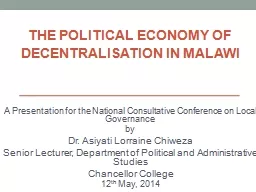PDF-DECENTRALISATION OF EMPLOYMENT POLICIES AND NEW FORMS
Author : lois-ondreau | Published Date : 2015-05-25
Decentralisation raises a number of challenges however both in terms of the degree of flexibility in policy management that it can yield in practice and the capacity
Presentation Embed Code
Download Presentation
Download Presentation The PPT/PDF document "DECENTRALISATION OF EMPLOYMENT POLICIES ..." is the property of its rightful owner. Permission is granted to download and print the materials on this website for personal, non-commercial use only, and to display it on your personal computer provided you do not modify the materials and that you retain all copyright notices contained in the materials. By downloading content from our website, you accept the terms of this agreement.
DECENTRALISATION OF EMPLOYMENT POLICIES AND NEW FORMS: Transcript
Download Rules Of Document
"DECENTRALISATION OF EMPLOYMENT POLICIES AND NEW FORMS"The content belongs to its owner. You may download and print it for personal use, without modification, and keep all copyright notices. By downloading, you agree to these terms.
Related Documents














